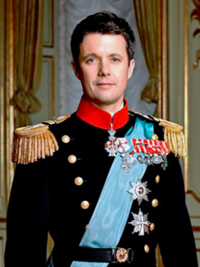Monarchy of Lyncanestria
| Emperor of Lyncanestria | |
|---|---|
| Audonic: Empereur de Lyncanestrie | |
Federal | |
 | |
| Incumbent | |
 | |
| Philippe IV since 8 July 2013 | |
| Details | |
| Style | His Imperial Majesty |
| First monarch | Philippe I |
| Formation | 27 October 1858 |
| Residence | Palais Beaulieu (official) |
| Appointer | Federal Council |
| Website | The Imperial Household |
The monarchy of Lyncanestria, also referred to as the Imperial Crown (Audonic: La Couronne impériale), is the ceremonial executive institution in Lyncanestria. The Lyncanestrian monarchy is comprised of the reigning monarch, his family, and the household who support and facilitate the monarch in the exercise of his official duties. The current reigning monarch is Philippe IV, who ascended to the throne on 8 July 2013.
The Lyncanestrian monarch is elected by the Federal Council, the upper house of the national legislature, and serves for life. The monarch's powers are delineated by a written constitution, the Imperial Charter of 1865, which outlines the executive functions of the office. Among these duties are bestowing honors and appointing some government officials with the advice and consent of His Majesty's Government. Although not officially and explicitly stated in the constitution, the monarchy is expected to remain non-partisan. The monarch is, by tradition, commander-in-chief of the Lyncanestrian Armed Forces although in times of war the monarch leaves such issues to the Prime Minister and his chief of staff.
The monarchy's roots are traced to the Lyncanestrian partition from Vannois in 1858, when the Lyncanestrian League broke from the Vannoisian monarchy and elected Philippe V of Barrois as the confederation's de facto leader. Originally seen as a primus inter pares, the concept of an elected executive with a largely ceremonial role as a symbol of national unity carried onto the constitution of 1865. Since the founding of the institution, the Imperial Crown has always been held by the Villeneuve kings of Barrois.
History
Background
Foundation
Changes in the 20th century
Contemporary monarchy
Public perception and image
Constitutional role
Succession
Succession to the imperial Lynacnestrian throne is governed by the constitution. Upon the death, abdication, or other incapacitation of the that would render the monarch incapable of fulfilling his duties, the Federal Council will convene to elect a new emperor. Those eligible to succeed as monarch must be at least 16 years, be "of sound mind" and are limited to "sovereign princes" of the Empire and her princely states. Cathrine, Queen of Barrois successfully argued in 1928 that the male-gendered language of the constitution did not disqualify a woman from holding the Imperial Crown.
In order to be elected monarch, a candidate need only receive a simple majority of votes in the Federal Council, which is comprised of 115 electors. Once elected, the monarch is invested by the primate of Lyncanestria, the Archbishop of Montroi. During the investiture ceremony, the newly elected monarch swears an oath to uphold the constitution, promote national unity, and defend national sovereignty.
Legislative and executive powers
The emperor and international diplomacy
The emperor as commander-in-chief
Official titles and styles
Per the constitution, the official title of the Lyncanestrian sovereign is "Emperor of Lyncanestria", though the monarch may choose to add other ceremonial titles associated with the monarchy as head of state. Officially, the emperor and his consort are addressed, "His Imperial Majesty" and "Her Imperial Majesty" (French: Votre Majesté, Votre represents His or Her). In the case of a female monarch, the empress' husband will be titled prince consort and styled His Imperial Highness (Votre Altesse Impérial). Children of the monarch are also granted the rank of Imperial Highness, even after the monarch has stopped reigning. Widows of an emperor also retain their style (Imperial Majesty) and title (Empress). Should the child of a former empress succeed to the emperorship, she may assume the title of empress mother.
Since the title of emperor is held conjointly with another title of a princely federal state, the Lyncanestrian monarch will simultaneously hold the rank of Imperial Majesty along with the titles and styles of his federal realm. The full title and style of the current reigning monarch is as follows;
- By the grace of God and will of the people, Philippe IV, Emperor of Lyncanestria, Sovereign King of Barrois, Defender of the Constitution and Leader of the Nation
- Par la grâce de Dieu et la volonté du peuple, Philippe IV, Empereur de Lyncanestrie, Roi souverain de Barrois, Défenseur de la Constitution et Chef de la Nation
Household
Residence
The Palais Beaulieu serves as the official residence of the Lyncanestrian monarch. Originally a
The imperial residence also houses multiple members of the Household Imperial Household